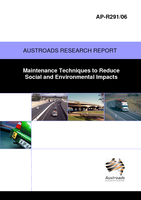Environment

Maintenance Techniques to Reduce Social and Environmental Impacts
- Publication no: AP-R291-06
- ISBN: 1 921139 40 4
- Published: 30 May 2006
- PDF (free) Download
Selection of maintenance techniques is always a balance between the administering authority costs and social and environmental costs and outcomes. This project provides practical information and a methodology (including a worked example) for considering the balance between these costs. Characteristics of the problem include: - a need to consider a broad range of beneficial outcomes including social, economic and environmental outcome areas in decision making in the context of constrained budgets - a need to consider a broad range of costs including environmental/social costs (delays, noise, air, water, land) and the administering authority costs. This report is intended to assist road managers and maintenance personnel in three ways: - to raise awareness that road maintenance can lead to social and environmental impacts - to emphasise that social and environmental values (in addition to engineering, technical and economic factors) may also drive the development of maintenance programs - to illustrate how the selection of maintenance techniques and operational approaches can both reduce the risk of adverse social and environmental impacts and enhance social and environmental values.
- AP-R291/06 Maintenance Techniques to Reduce Social and Environmental Impacts
- EXECUTIVE SUMMARY
- CONTENTS
- TABLES
- FIGURES
- 1. INTRODUCTION
- 1.1. Structure of the report
- 2. PART I: AN INTRODUCTION TO SOCIAL ANDENVIRONMENTAL IMPACTS OF ROAD MAINTENANCE
- 2.2. Social and environmental impacts of maintenance activities
- 2.3. Managing social and environmental impacts
- 2.4. Valuing social and environmental externalities
- 3. PART II: SOCIAL AND ENVIRONMENTAL DRIVERS OFROAD MAINTENANCE
- 3.1. Identifying social and environmental drivers
- 3.2. Examples of social and environmental perspectives
- 4. PART III: A FRAMEWORK FOR SELECTINGMAINTENANCE TECHNIQUES
- 4.1. Developing a road maintenance program
- 4.1.1. Setting priorities
- 4.1.2. Key principles
- 4.1.3. Asset types
- 4.2. Key questions
- 4.3. Choosing between alternative treatments or ‘techniques’
- 4.3.1. The selection process
- 4.3.2. Factors to consider
- 4.3.3. Using asset type and defect type as a guide
- 4.3.4. Using severity to guide treatment selection
- 4.4. Risk assessment and management – maintenance implementation
- 4.4.1. Environmental management plans (EMP)
- 4.4.2. Risk management guidelines
- 4.5. Worked example: analysis of alternative road rehabilitationtreatments
- 4.5.1. Overview of example
- 4.5.2. Hypothetical worked example
- 5. CONCLUSIONS
- REFERENCES
- FURTHER READING
- APPENDIX A ROAD MAINTENANCE ACTIVITIES
- A.1 Pavement maintenance activities
- A.2 Bridge maintenance activities
- A.3 Roadside maintenance activities
- APPENDIX B INFORMATION NOTES: MAINTENANCETECHNIQUES TO REDUCE SOCIAL ANDENVIRONMENTAL IMPACTS
- INFORMATION RETRIEVAL
Related publications
WEB-PROJECTS-23
Latest Environment News
